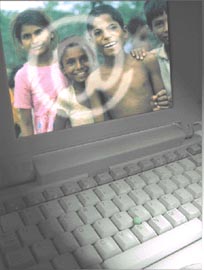Breaching the digital divide
 There was a village in India, far away from the highway. It had become very poor. The land yielded very little. Water was either scarce or polluted. The forest had been razed. Village folk would migrate to town for employment. They’d heard of computers. It didn’t mean a thing. They had heard that rich city folk send their children to ‘America’ to become software engineers. This, too, meant nothing. The village school taught children till fifth standard only.
There was a village in India, far away from the highway. It had become very poor. The land yielded very little. Water was either scarce or polluted. The forest had been razed. Village folk would migrate to town for employment. They’d heard of computers. It didn’t mean a thing. They had heard that rich city folk send their children to ‘America’ to become software engineers. This, too, meant nothing. The village school taught children till fifth standard only.
One day came a government official in a jeep. He was treated like a king. They gave him tea prepared with only milk, and biscuits bought from the only shop that stocked them. He said the government was going to set up a kiosk with computers. Farmers would be able to ‘access’ land records and rates of agricultural produce from markets across the country in no time. Latest government schemes for development would become more accessible. Educating children would become easier. There was talk of villages where computers had changed lives. Could it be true? Information, the villagers knew, was always locked in the files of the patwari (keeper of the land records), and he always demanded money. The old-timers refused to give credence to all the compu-talk. They had seen many official visits and many gizmos. The electricity supply was as infrequent as the rains. And there wasn’t a phone line in a radius of 10 km....
From here the story can go anywhere. Information technology (it) is at a stage where it is generating a lot of talk and, it must be said, hype. Every other day, you will read or hear politicians and bureaucrats announce new it schemes. They never fall short of promising a revolution; benefits for the poorest of the poor and bringing India’s villages to the ‘national mainstream’. There are two kinds of reactions to this hype. One is sceptical, typical of the old-timers in our little tale who see nothing in computers but another expression of the plastic age. The other reaction is stupefaction, more typical of the younger generation ever ready to embrace something new, even if it promises the moon and stars to boot.
The reality, fortunately, is not as stereotypical.
No, it will not usher in the dawn of a brave new world, transforming Indian villages into stuff that makes advertising brochures. But yes, it is a great tool, which, if properly used, could improve the life of millions. But some daunting problems need to be conquered first. Three of the most important ones are:
• Power availability; a major worry in a power-starved country that can’t adequately power its cities, forget villages.
• Connectivity, through telephone cables or otherwise; would require some imaginative thinking.
• Software in Indian languages; not difficult in a country that leads the software market.
There are numerous solutions. Experts have already come out with loads of good suggestions. They need to be heeded with urgency. Information is important. Market rates are crucial, as much for the stockbroker on Mumbai’s Dalal Street as the farmer who looks for the market that offers the best price for the season’s produce. Yet the benefits of India’s it boom have been restricted to the urban elite. Experts in it point out that the trickle-down theory
